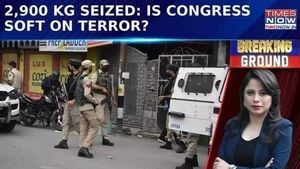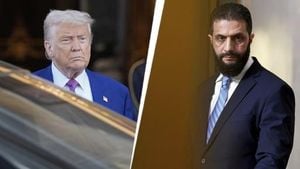On October 15, 2025, a remarkable scene unfolded at the Pentagon: dozens of seasoned reporters, some with more than a decade at their desks, packed up their belongings and handed in their access badges. Chairs, a copying machine, stacks of books, and cherished old photos were carried out to the parking lot, signaling a mass exodus in protest against newly imposed restrictions by the Trump administration. The move, which left the Pentagon’s once-bustling press workspaces eerily empty, marked a rare and dramatic act of defiance by the press corps against what they described as an unprecedented threat to journalistic independence.
The flashpoint for this protest was a set of new reporting rules issued by Secretary of Defense Pete Hegseth. Under these regulations, journalists risked expulsion from the Pentagon for reporting on any information—classified or otherwise—that had not been specifically approved for release by Hegseth himself. According to The Atlantic, the rules would have required reporters to sign a document acknowledging these restrictions, a move Hegseth insisted was merely “common sense” and not an official agreement. "Having journalists sign a document is only to acknowledge the rules rather than serving as an official agreement," Hegseth said, but reporters saw little difference, arguing that the effect was to chill independent reporting and consolidate control over information.
News organizations across the political spectrum were nearly unanimous in their rejection of these new rules. From legacy outlets like The Associated Press and The New York Times to conservative stalwarts such as Fox News and Newsmax, editors directed their Pentagon reporters to leave rather than acquiesce. The only notable exception was One America News Network, which chose to sign on. The Pentagon Press Association, representing 101 journalists from 56 news organizations, issued a strong condemnation of the restrictions, echoing the widespread sentiment that the new rules were a step too far.
"It’s sad, but I’m also really proud of the press corps that we stuck together," said Nancy Youssef, a reporter for The Atlantic who has covered the Pentagon since 2007, in an interview with the ABQ Journal. Her words captured the bittersweet mood as the journalists left their posts en masse shortly after the Defense Department’s 4 p.m. deadline. The sight of boxes lining the corridors and a steady stream of reporters making their way out underscored the gravity of the moment.
The Trump administration, for its part, defended the new rules as necessary to regulate what it called a “very disruptive” press. Speaking at the White House on October 14, President Trump himself weighed in, telling reporters, “I think [Secretary Hegseth] finds the press to be very disruptive in terms of world peace. The press is very dishonest.” The administration’s stance made clear that the new approach was not just about classified information but about tightening control over the entire flow of information from the Pentagon.
Secretary Hegseth, a former Fox News host, has been a particularly contentious figure among the Pentagon press corps. Since his appointment, he has held just two formal press briefings, sharply restricted journalists’ access to many areas of the Pentagon without an escort, and launched several investigations into leaks. According to AP News, these moves were seen as part of a broader effort to limit transparency and public scrutiny of military affairs.
Veteran military analyst and retired U.S. Army general Jack Keane was blunt in his assessment: "What they’re really doing, they want to spoon-feed information to the journalist, and that would be their story. That’s not journalism." The sentiment was echoed by many in the press corps, who saw the new rules as an attempt to replace independent reporting with carefully curated narratives, distributed through official social media posts, short videos, and interviews with partisan commentators.
The editorial pages were quick to weigh in as well. According to an editorial in the Baltimore Sun, “Americans should be proud of Pentagon reporters who refused to cave to Hegseth's heavy-handed effort to curb public scrutiny of military.” The piece lauded the journalists’ principled stand and warned that the restrictions set a dangerous precedent for government transparency.
Tom Bowman, an NPR reporter who joined the walkout, wrote in an essay that "with no reporters able to ask questions, it seems the Pentagon leadership will continue to rely on slick social media posts, carefully orchestrated short videos and interviews with partisan commentators and podcasters. No one should think that’s good enough." His remarks highlighted concerns that, in the absence of independent journalists, the public would be left with only the official version of events.
The protest at the Pentagon is not occurring in a vacuum. It comes amid a broader climate of tension between the Trump administration and the media, with repeated accusations of dishonesty and disruption leveled at journalists. The administration’s approach to press relations has been marked by frequent clashes, limited access, and a preference for direct communication through social media and sympathetic outlets.
Despite the walkout, news organizations have vowed to continue robust coverage of the U.S. military, even if it means doing so from outside the Pentagon’s walls. As one senior editor put it, “We may not have a desk inside, but we’re not going to stop asking tough questions.” The commitment to watchdog journalism remains strong, even as the physical and procedural barriers have grown.
The practical impact of the new rules remains to be seen. While the administration has insisted that the changes are about protecting national security and ensuring orderly communication, critics argue that the real effect will be to shield officials from uncomfortable questions and reduce public accountability. As the story continues to unfold, the nation is left to ponder what it means for democracy when the press is pushed further from the seat of power.
The Pentagon walkout stands as a vivid reminder of the ongoing struggle over transparency, accountability, and the essential role of a free press in American life. Whether this protest will prompt a change in policy or simply mark another chapter in the long-running battle between government and media remains to be seen, but for now, the message from the journalists is clear: the public’s right to know is worth fighting for—even if it means leaving the building behind.





